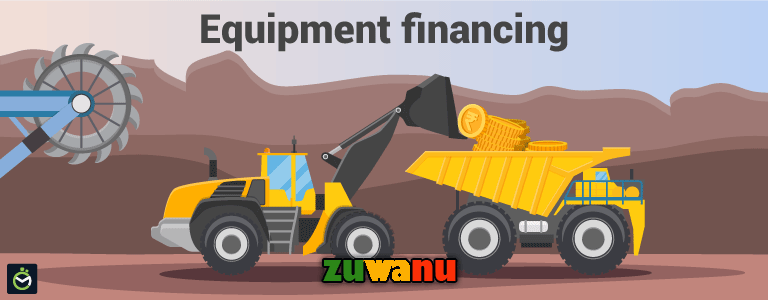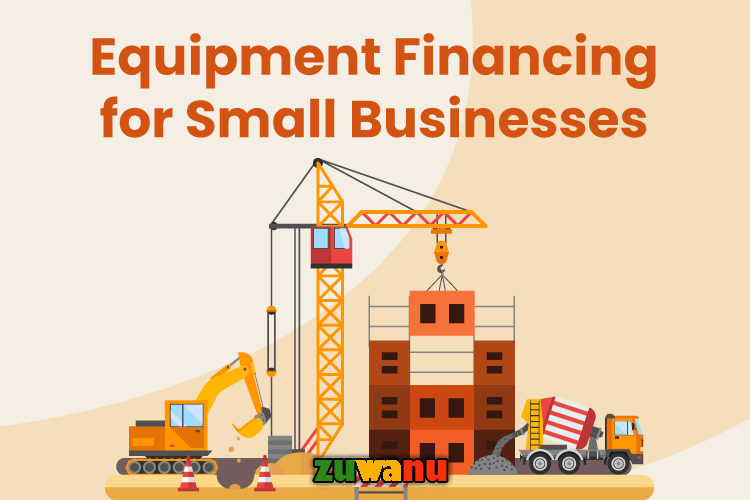Guide to Equipment Financing: Types, Companies, Requirements, and More
Table of Contents
Introduction (Equipment Financing)

Equipment financing is a crucial aspect of business operations, especially for startups and small businesses. Whether you’re launching a new venture, expanding an existing one, or simply need to upgrade your equipment, equipment financing can provide the capital you need to acquire the necessary tools and machinery.
In this comprehensive guide, we will delve into everything you need to know about equipment financing. We’ll explore the various types of equipment financing, discuss the equipment financing companies that offer these services, examine the requirements for equipment financing, and address specific scenarios such as equipment financing for startups, startup equipment financing for individuals with bad credit, and used equipment financing.
Additionally, we will analyze the pros and cons of equipment financing to help you make informed decisions for your business.
I. Types of Equipment Financing
Equipment financing offers various options to suit the unique needs of different businesses. The choice of financing depends on factors such as the type of equipment needed, your business’s financial situation, and your long-term goals. Here are the main types of equipment financing:
- Equipment Lease
- Operating Lease: In an operating lease, you essentially rent the equipment for a specific period without the obligation to purchase it at the end. This is ideal for businesses that need the latest equipment and don’t want to commit to long-term ownership.
- Capital Lease: A capital lease, also known as a finance lease, is similar to a loan. You make fixed monthly payments and typically have the option to purchase the equipment at the end of the lease term for a nominal amount. This is a good option for businesses that plan to keep the equipment long-term.
- Equipment Loans
- Term Loans: Equipment loans are structured like traditional business loans, with a fixed interest rate and term. These loans are used to purchase equipment outright, and the equipment serves as collateral. The business owns the equipment from day one.
- SBA Loans: The Small Business Administration (SBA) offers loans that can be used for equipment financing. These loans come with favorable terms and lower interest rates, making them an attractive option for qualifying businesses.
- Equipment Financing Agreements: These agreements are specifically designed for equipment purchases. They allow you to borrow a specific amount of money to buy the equipment, which then serves as collateral for the loan.
- Equipment Sale-Leaseback
- In a sale-leaseback arrangement, a business sells its existing equipment to a leasing company and then leases it back. This provides an infusion of capital while allowing the business to continue using the equipment. It’s a creative way to unlock the equity in your owned equipment.
- Vendor Financing
- Some equipment manufacturers or suppliers offer financing options to their customers. These financing agreements are often convenient and tailored to the equipment being sold. They can be a great choice if you’re buying equipment from a specific vendor.
II. Equipment Financing Companies
When seeking equipment financing, you have several options for where to obtain the financing. Equipment financing companies specialize in providing financial solutions for businesses looking to acquire the tools and machinery they need to operate. Below are some of the types of entities that offer equipment financing:
- Traditional Banks:
- Many traditional banks offer equipment financing options. They provide term loans and lease options to businesses. Banks are a good choice for established businesses with strong credit histories.
- Credit Unions:
- Credit unions often have competitive rates and are known for their personalized service. They may offer equipment financing solutions to their members, which can be beneficial for small businesses.
- Online Lenders:
- Online lenders, like Kabbage, OnDeck, and BlueVine, offer equipment financing solutions that are quick and convenient. They may have less stringent requirements than traditional banks.
- Equipment Leasing Companies:
- These specialized companies focus exclusively on equipment leasing and financing. They understand the specific needs of different industries and often offer flexible terms.
- Manufacturer or Vendor Financing:
- Equipment manufacturers and vendors frequently provide financing options to customers. This is a convenient choice when buying equipment directly from the source.

- Small Business Administration (SBA):
- The SBA offers various loan programs, including those that can be used for equipment financing. SBA loans are known for their favorable terms and low interest rates.
- Equipment Financing Brokers:
- Equipment financing brokers act as intermediaries between businesses seeking financing and lenders. They can help businesses find the best financing options that match their needs and credit profile.
Choosing the right financing company depends on your specific requirements, the type of equipment you’re acquiring, your credit history, and the terms that best align with your business goals.
III. Equipment Financing Requirements
To secure equipment financing, you’ll need to meet certain requirements. While the specific criteria can vary depending on the lender or financing type, here are some common requirements:
- Creditworthiness:
- Your personal and business credit scores play a significant role in the approval process. Lenders use credit scores to assess the risk of lending to your business. A higher credit score generally increases your chances of approval and may lead to better terms.
- Financial Documents:
- Lenders typically require financial documents, including your business’s balance sheets, income statements, cash flow statements, and tax returns. These documents demonstrate your business’s financial health and ability to repay the loan.
- Business Plan:
- A well-structured business plan is important, especially for startups. It should outline your business model, market analysis, revenue projections, and how the equipment will contribute to your success.
- Down Payment:
- Some equipment financing options may require a down payment, which can range from 10% to 20% of the equipment’s cost. This acts as a form of collateral and reduces the lender’s risk.
- Time in Business:
- Lenders often prefer to work with established businesses with a proven track record. Some may require that your business has been in operation for a minimum number of years, which can vary.
- Collateral:
- In some cases, the equipment itself serves as collateral for the loan. If you default on the loan, the lender can repossess the equipment. For unsecured loans, personal guarantees may be necessary.
- Industry and Equipment Type:
- The type of equipment you’re financing and the industry you’re in can influence the approval process. Some lenders may be more willing to finance equipment in certain industries, while others may have restrictions.
- Business Credit History:
- If you have a well-established business credit history, it can improve your chances of approval and lead to better terms. Building business credit is essential for long-term financial health.
- Cash Flow:
- Lenders evaluate your business’s cash flow to ensure that you can comfortably make the loan payments. Strong and consistent cash flow can positively impact your application.
- Personal Guarantees:
- In many cases, lenders may require personal guarantees from business owners, especially for startups or businesses with limited credit history. A personal guarantee means that you are personally liable for the loan.
It’s important to note that different lenders may have varying requirements, so it’s advisable to shop around and compare offers to find the best fit for your business’s needs.
IV. Equipment Financing for Startups
Startups often face unique challenges when it comes to equipment financing. Limited credit history, lack of collateral, and uncertainty about future cash flow can make it more difficult to secure financing. However, several options are available for startups looking to
Paving Equipment Financing Options: A Comprehensive Guide
acquire the equipment they need:
- Equipment Leasing:
- Leasing is often a viable option for startups because it doesn’t require a substantial upfront investment. It’s less restrictive in terms of credit requirements, making it more accessible to businesses with limited credit history.
- SBA Loans:
- The Small Business Administration offers several loan programs that can benefit startups. While these loans may have stricter eligibility requirements, they typically come with favorable terms and lower interest rates.
- Vendor Financing:
- When purchasing equipment from a manufacturer or vendor, inquire about their financing options. Some vendors offer equipment financing designed for startups and small businesses, with more flexible terms.
- Crowdfunding and Grants:
- Some startups explore alternative funding sources like crowdfunding and grants to acquire equipment. Crowdfunding platforms allow you to raise funds from a large group of investors, while grants are non-repayable funds provided for specific purposes.
- Equipment Sharing:
- In some cases, startups can partner with established businesses or industry peers to share equipment. This can help reduce the initial financial burden while still gaining access to necessary tools.
- Angel Investors and Venture Capital:
- Some startups secure equipment financing through angel investors or venture capital firms. These investors may provide funding in exchange for equity or convertible debt.
While it can be more challenging for startups to secure equipment financing, it’s not impossible. Building a strong business plan and exploring various financing options can increase your chances of success.
V. Startup Equipment Financing for Individuals with Bad Credit
If you’re a startup owner with bad credit, it’s important to acknowledge the challenges you may face when seeking equipment financing. Bad credit can make it more difficult to secure traditional financing options. However, there are alternatives and strategies to consider:
- Co-Signer:
- A co-signer with good credit can strengthen your loan application. By co-signing, they assume responsibility for the loan if you’re unable to meet the payments, making lenders more inclined to approve your application.
- Collateral:
- Offering valuable collateral, such as personal or business assets, can mitigate the risk for lenders, potentially increasing your chances of approval.
- Equipment Leasing:
- As mentioned earlier, equipment leasing is often more lenient in terms of credit requirements. It can be a suitable choice for startup owners with bad credit, as it requires smaller upfront costs and may not involve a credit check.
- Online Lenders:
- Some online lenders are more willing to work with businesses and individuals with bad credit. While these loans may have higher interest rates, they can provide access to the equipment you need.
- Equipment Financing Brokers:
- Equipment financing brokers have connections with multiple lenders and can help match you with one that is more likely to work with your credit situation.
- Improve Your Credit:
- Consider taking steps to improve your personal and business credit over time. This may involve paying off outstanding debts, settling any judgments, and making consistent, on-time payments.
- Nonprofit and Alternative Lenders:
- Explore nonprofit lenders and alternative financing options designed to assist businesses and individuals with challenging credit histories.
- Crowdfunding and Grants:
- Depending on your startup’s industry and focus, crowdfunding and grant opportunities may be available to help fund the equipment you need, regardless of your credit history.
It’s important to be proactive in addressing your bad credit and seeking solutions. While financing options may be limited, with determination and careful planning, you can find a way to acquire the necessary equipment for your startup.
VI. Used Equipment Financing
Used equipment financing is a practical choice for businesses looking to save costs while still obtaining reliable machinery. Whether you’re purchasing used equipment due to budget constraints or because it fits your business needs, here’s what you should know about financing used equipment:
- Advantages of Used Equipment Financing:
- Cost Savings: The most apparent benefit of buying used equipment is cost savings. Used machinery is generally priced lower than new, which can significantly reduce your upfront investment.
- Faster ROI: Lower initial costs mean a quicker return on investment (ROI) since you’ll need less revenue to cover the equipment expenses.
- Depreciation: New equipment depreciates quickly in its first few years, whereas used equipment has already experienced most of its depreciation. This can be an advantage for tax purposes.
- Reliability: Used equipment, if well-maintained, can be just as reliable as new equipment, especially in industries where machinery has a long lifespan.
- Challenges of Used Equipment Financing:
- Availability: Finding specific used equipment in good condition can sometimes be a challenge, especially if you have very specific requirements.
- Financing Terms: Some lenders may offer less favorable terms for used equipment, such as shorter loan durations or higher interest rates.
- Maintenance and Repairs: While used equipment can be cost-effective upfront, you might need to budget for maintenance and repairs if the equipment is older and has wear and tear.
- Financing Options for Used Equipment:
- Equipment Loans: Traditional term loans and equipment financing agreements can be used to purchase used equipment. Lenders may evaluate the age, condition, and resale value of the equipment to determine loan terms.
- Equipment Leasing: Leasing is a popular option for used equipment, as it often offers more flexibility and lower upfront costs. The lease terms may be adjusted to reflect the equipment’s age and condition.
- Vendor Financing: Some equipment vendors offer financing options for their used equipment. These deals can be convenient, and the vendor’s expertise ensures the equipment’s quality.
- Online Lenders: Online lenders may be more open to financing used equipment, especially for businesses with good credit.
When considering used equipment financing, it’s essential to conduct a thorough inspection of the equipment and review its maintenance and repair history to ensure it’s a sound investment. Additionally, carefully compare the terms and interest rates of various lenders to get the best deal.
VII. Pros and Cons of Equipment Financing
As with any financial decision, equipment financing comes with its own set of advantages and disadvantages. Understanding these can help you make informed choices for your business. Here are the pros and cons of equipment financing:
Pros:
- Preservation of Capital: Equipment financing allows you to acquire essential machinery without depleting your cash reserves. This capital can be better allocated to other aspects of your business, such as expansion, marketing, or hiring.
- Tax Benefits: Depending on your location and the specific terms of your financing arrangement, you may be eligible for tax benefits. These can include depreciation deductions and interest expense deductions, potentially reducing your overall tax liability.
- Improved Cash Flow: Equipment financing typically involves fixed monthly payments, which makes budgeting more predictable. This can help maintain a steady cash flow and manage your business finances effectively.
- No Need for Large Upfront Payments: Leasing, in particular, often requires little to no upfront payment, which can be advantageous for startups or businesses with limited capital.
- Access to Up-to-Date Equipment: Leasing allows you to regularly upgrade to the latest equipment technology, ensuring that your business remains competitive.
- Collateral-Based Financing: For secured loans, the equipment itself serves as collateral, reducing the lender’s risk and potentially making it easier for businesses with limited credit history to secure financing.
Cons:
- Interest Costs: Financing, especially for longer terms, can result in higher overall costs due to interest. It’s important to compare interest rates and terms to minimize these costs.
- Commitment: Some financing options, like capital leases, require a long-term commitment, which might not be ideal if your business’s needs change rapidly.
- Ownership Delays: In leasing arrangements, you don’t own the equipment, which means you won’t benefit from any appreciation in its value. If ownership is a priority, a loan or capital lease might be a better choice.
- Eligibility Requirements: Financing is subject to eligibility criteria, and not all businesses may qualify. Bad credit or limited business history can make it challenging to secure financing.
- Risk of Default: If you default on your financing agreement, you may lose the equipment or face legal action, depending on the terms of the contract.
- Impact on Debt-to-Equity Ratio: Taking on equipment financing adds debt to your business’s balance sheet, which can impact your debt-to-equity ratio. This may affect your ability to secure additional financing in the future.
Conclusion
Equipment financing is a valuable tool for businesses of all sizes, providing the means to acquire the necessary equipment without depleting capital or taking on excessive financial risk. Understanding the various types of equipment financing, the requirements, and the pros and cons is essential for making well-informed decisions for your business.
Whether you’re a startup owner with limited credit history, seeking used equipment financing to save costs, or exploring the advantages of vendor financing, there are options available to suit your unique circumstances. Remember to shop around, compare offers, and consult with financial experts or equipment financing brokers to find the best solution that aligns with your business goals.
By carefully assessing your needs and financial situation, you can leverage equipment financing to boost your business’s productivity and profitability while maintaining financial stability and flexibility. In today’s competitive business landscape, equipment financing is a valuable resource for staying ahead and achieving your long-term objectives.
